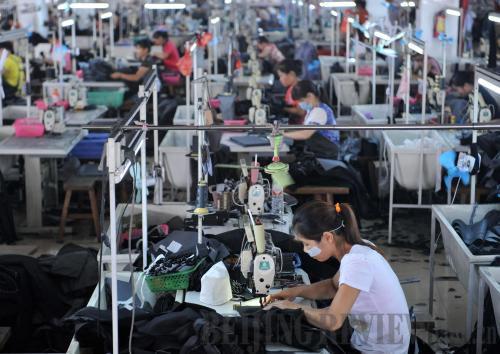 |
|
CLIMBING UP THE VALUE CHAIN: Workers sew clothes in a factory in Fumian District of Yulin, southwest China's Guangxi Zhuang Autonomous Region. Dubbed the "world hub of trousers manufacturing," the district produces over 200 million clothes annually (ZHOU HUA) |
Weak links
Analysts, however, said the top trader spot is no reason for gloating as China is far from being a strong trading nation due to a lack of hi-tech exports and the lackluster service-trade data.
"Among our exported goods, most of them have an economically low added value and we have few of our own brands. We still lag behind in global marketing networks and models," said Gao.
In 2013, China's exports of hi-tech products accounted for 29.9 percent of its total exports, but 73 percent of those products were made by foreign-invested companies, according to data from the MOFCOM.
Processing trade still occupies the bulk of China's foreign trade, said Liu Yuanchun, Deputy Dean of School of Economics at the Renmin University of China. A large amount of components are brought to China to be assembled and then re-exported. MOFCOM figures show the processing trade made up 32.6 percent of total imports and exports in 2013.
"The core technologies are in the hands of foreign companies or joint ventures while Chinese manufacturers are still at the lower end of the industrial chain, living off very thin profits," said Liu.
"For a long time, Chinese products have relied on quantity and price advantages for international competitiveness, while lacking core competitiveness and added value," said Bai. "China is making products that other countries are not willing to. Although it is the top trader of goods, profits belonging to China are definitely not in line with that status."
Besides the structural problem in China's trade of goods, another piece of evidence for China not being strong enough in trade is that its service trade still lags far behind the United States. International trade, however, is now edging away from commodities to services and intellectual property, which happen to be China's weaknesses.
China's shortcoming in service trade represents a stumbling block on the country's path to becoming a stronger trading nation. According to the MOFCOM, China's service trade reached $539.64 billion in 2013, accounting for 11.5 percent of its total trade volume, far below the world average of 20 percent. The amount is also less than half of that for the United States.
The country also saw a widening deficit of $118.46 billion in service trade in 2013, surging 32.1 percent from the $89.7 billion deficit in 2012. Overall, the country has witnessed a deficit in service trade for 12 consecutive years, according to the MOFCOM.
| 